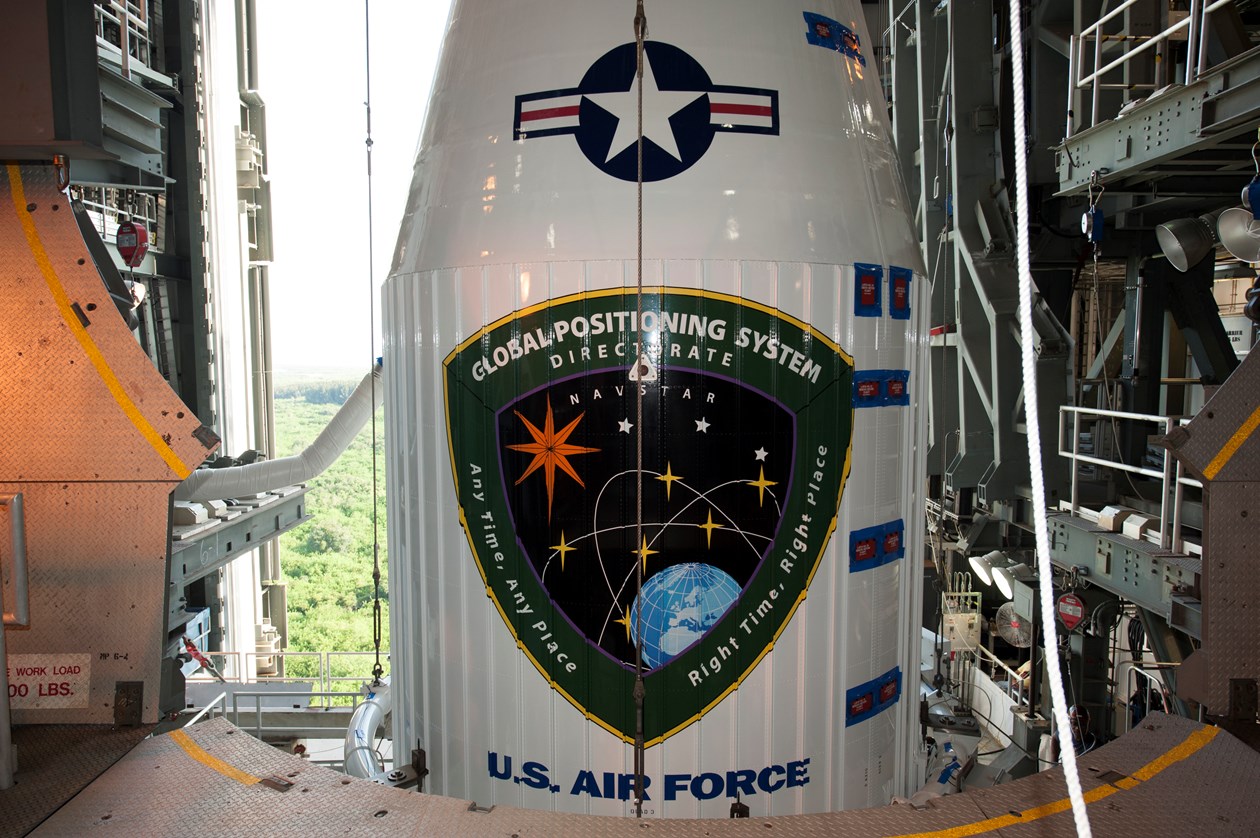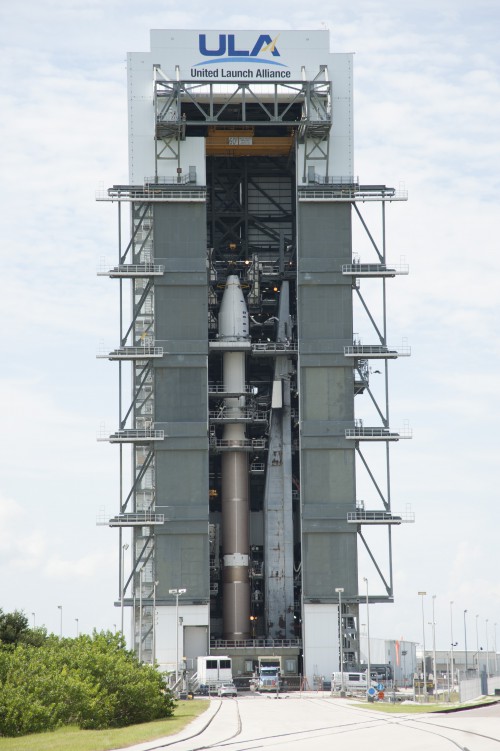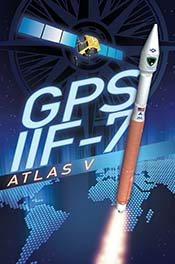
With eight successful launches under its belt so far in 2014, United Launch Alliance (ULA) is set to attempt a ninth on Friday, 1 August, with the flight of an Atlas V booster from Space Launch Complex (SLC)-41 at Cape Canaveral Air Force Station, Fla. Liftoff of the vehicle, which is flying in its “401” configuration—numerically designated to describe a 13-foot-diameter (4-meter) payload fairing, no strap-on rockets, and a single-engine Centaur upper stage—is scheduled to occur at 11:23 p.m. EDT, at the opening of an 18-minute “window.” The Atlas will transport the seventh Global Positioning System (GPS) Block IIF satellite into a medium orbit, some 11,047 nautical miles (20,460 km) above Earth. Coming just four days after Monday’s successful launch of the Air Force Space Command (AFSPC)-4 mission, a successful flight on Friday will mark the third occasion that ULA has accomplished two missions within the span of a single week in 2014.
It has been a spectacular year for ULA, which has thus far seen no less than four Atlas V missions, three Delta IV Medium+ (4,2) missions, and the 2 July return to flight of the venerable Delta II. Having flown pairs of missions within a single week in both April and May, 2014 will be the first time in ULA’s eight-year operational history that it has supported two missions, within the same week, on as many as three discrete occasions, within a single calendar year. Back in 2007, the company delivered pairs of Atlas and Delta missions within one-week periods in June and December; furthermore, in the latter month, it actually succeeded in launching three vehicles (one Atlas V and a pair of Delta IIs) within just 11 days of each other. By launching for a cumulative ninth time in barely eight months in 2014, the GPS IIF-7 mission will also allow ULA to record three times as many flights as its leading competitor, SpaceX, against whose criticism it responded with a dignified, yet punishing, “Results over Rhetoric” salvo several weeks ago.
At the time of writing, the 196-foot-tall (60-meter) Atlas V booster was scheduled to roll out, atop its Mobile Launch Platform (MLP), from the Vertical Integration Facility (VIF), on Thursday, 31 July, for the 35-minute journey to SLC-41. Upon arrival at the pad, it would be carefully centered and propellant umbilicals and electrical and data links would be connected. The track mobiles will be removed later Thursday, and ULA engineers will prepare for formal GPS IIF-7 countdown operations, which are slated to commence on Friday. Following a highly dynamic weather situation in the build-up to last week’s AFSPC-4 launch, conditions for Friday night’s flight promise to be marginally calmer. According to Patrick Air Force Base meteorologists, evening conditions are expected to be mainly cloudy, with a possibility of rain and lightning, but ULA anticipates conditions to be 70 percent favorable at T-0.

The GPS IIF-7 mission will be the third occasion in 2014—following February’s launch of GPS IIF-5 and May’s flight of GPS IIF-6—that a member of the “interim” Block II Global Positioning System constellation of satellites has been delivered into orbit. In total, it will be the 11th operational GPS to be launched by a ULA vehicle, since the company’s formation in December 2006, and only the second in history to be lofted atop an Atlas V. It is anticipated that the 12-satellite GPS Block IIF network will employ a mixture of both Atlas V and Delta IV launches, with the latter employed to place both GPS IIF-5 and IIF-6 into orbit, and an Atlas V slated to deliver GPS IIF-8 in October. Friday night’s mission will help to keep the Navstar network of worldwide positioning, velocity, and timing assets fully operational until the next-generation GPS Block IIIA comes online in 2016.
The Atlas V 401’s Russian-built RD-180 engine, with a propulsive yield of 860,000 pounds (390,000 kg), will ignite about 2.7 seconds ahead of Friday’s liftoff, burning a mixture of liquid oxygen and a refined form of rocket-grade kerosene, known as “RP-1.” Climb-out from SLC-41 will commence at T+1.1 seconds, and the pencil-like vehicle will climb vertically for about 16 seconds, after which the avionics of the Centaur upper stage will command a pitch, roll, and yaw program maneuver. This will establish the Atlas onto the proper flight azimuth of 45.8 degrees, following a north-easterly trajectory to inject the 3,600-pound (1,630-kg) GPS IIF-7 satellite into orbit.
After the shutdown of the RD-180—whose Russian heritage has made ULA the subject of much criticism in recent months, particularly in light of sanctions issued in the aftermath of the Kremlin’s annexation of Crimea—at about four minutes into the flight, the 41-foot-long (12.4-meter) Centaur and attached GPS IIF-7 payload will be detached, preparatory to a pair of “burns” to achieve a target orbit of 11,047 nautical miles (20,460 km), inclined 55 degrees to the equator. Ignition of the Centaur’s 22,300-pound-thrust (10,100-kg) RL-10A engine for the first time will occur about 10 seconds after the separation of the Atlas V’s first stage. It employs a cryogenic combination of liquid oxygen and hydrogen and is designed to be restartable. The first firing will be followed by the jettisoning of the two-piece (or “bisector”) payload fairing to expose GPS IIF-7 to the space environment for the first time. According to ULA’s launch kit, the initial burn is scheduled to last 13 minutes, after which the Centaur/payload combo will coast for almost three hours, ahead of a second burn, lasting just 1.5 minutes. After this event, the Centaur will spin-up GPS IIF-7 to five revolutions per minutes and release it into space at T+3 hours and 23 minutes.
Throughout the ascent phase, telemetry data will be gathered by the Eastern Range, together with various worldwide installations under the U.S. Air Force Space Command Network, including New Boston Air Force Station, N.H., the Royal Air Force’s Oakhanger installation in Hampshire, England, Diego Garcia in the Indian Ocean, and Guam in the western Pacific Ocean. Additionally, NASA’s Tracking and Data Relay Satellite System (TDRSS) will participate in the gathering of telemetry.

From its semi-synchronous, medium-altitude Earth orbit, GPS IIF-6 will circle Earth once every 12 hours. It represents the seventh satellite in a 12-strong network of GPS Block IIF spacecraft, the first of which was launched in May 2010. A second satellite followed in July 2011, then a third in October 2012, and a fourth in May 2013. Two more were launched in February and May 2014.
The GPS IIF boasts improved positioning, velocity, and timing accuracy, a reprogrammable processor, an interference-free civilian signal for commercial aviation search and rescue, and a new Military code (or “M-code”) to offer better resistance to electronic jamming. “As each IIF satellite becomes operational, we continue the seamless transformation of the GPS constellation into an even more accurate, reliable, and durable navigation resource for the U.S. military and the global civilian user community,” said Craig Cooning, vice president and general manager of Boeing Space & Intelligence Systems. “Our efficient pulse-line manufacturing process, adapted from Boeing’s commercial airplane production lines, also ensures that we deliver each spacecraft on time and on cost.”
In the meantime, the Air Force expects the next-generation GPS IIIA network to enter service no earlier than April 2016, about two years later than originally intended. It awarded a $1.4 billion contract to Lockheed Martin in May 2008 to develop this new network, which may eventually comprise as many as 32 satellites, although the Air Force has only formally contracted for four of these. With 500 times the transmitter power of current systems, the IIIA satellites will benefit from improved navigational warfare capabilities, enabling them to shut off GPS services to limited geographical locations, whilst maintaining service to U.S. and allied forces. The GPS satellite system is operated and controlled by the 50th Space Wing, located at Schriever Air Force Base, Colo.
Want to keep up-to-date with all things space? Be sure to “Like” AmericaSpace on Facebook and follow us on Twitter: @AmericaSpace
Missions » GPS » GPS IIF-7 »


